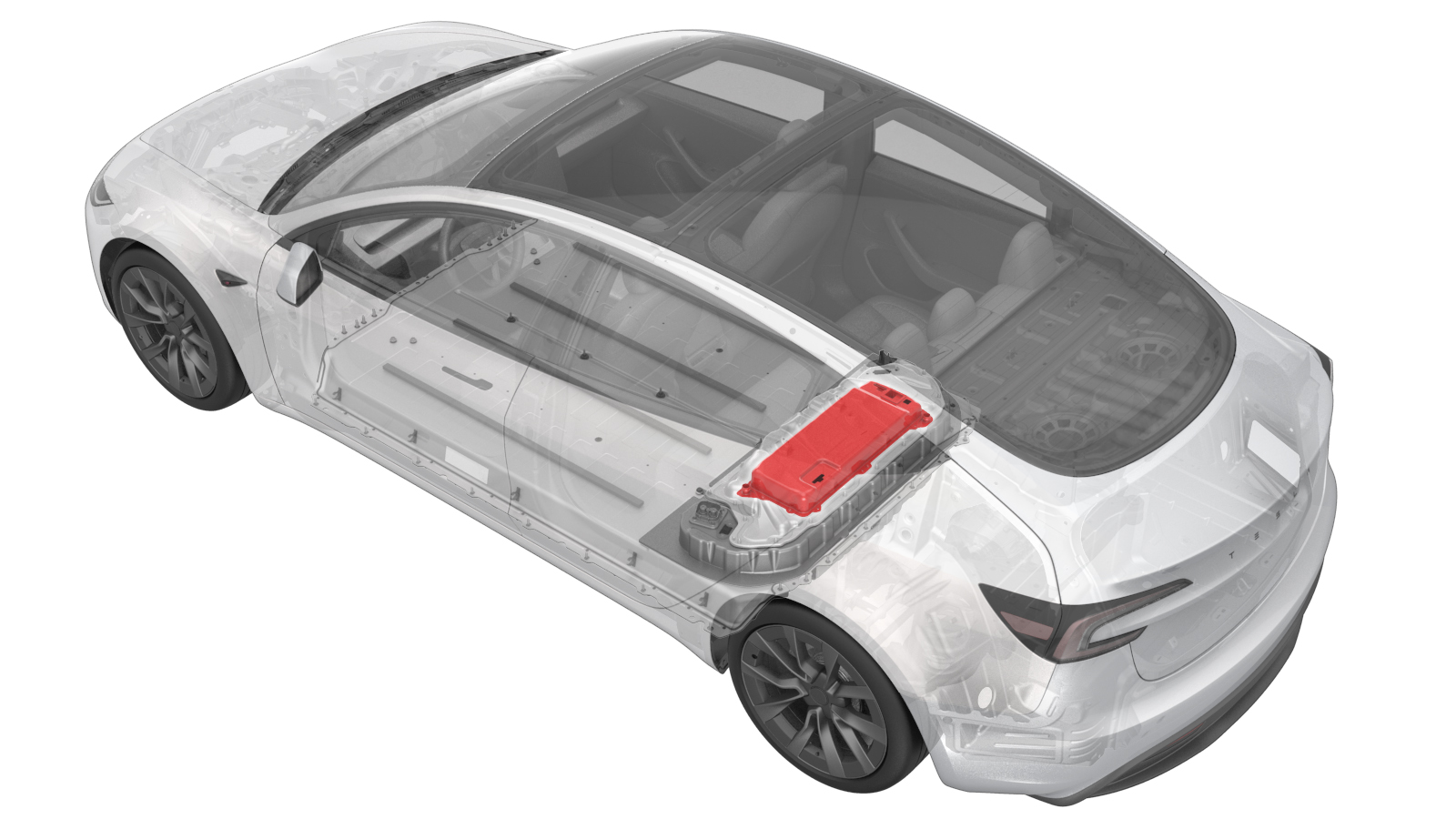2025-11-22
PCS 总成 ((拆卸和更换))
 校正代码
1630010252
FRT
2.22
注意:除非本程序中另有明确规定,否则上述校正代码和 FRT 反映的是执行本程序(包括关联程序)所需的所有工作。除非明确要求,否则请勿堆叠校正代码。
注意:请参阅平均维修工时,深入了解 FRT 及其创建方式。要提供有关 FRT 值的反馈,请发送电子邮件至ServiceManualFeedback@tesla.com。
注意:请参阅 人员保护,确保在执行以下程序时穿戴适当的个人防护装备 (PPE)。
注意:请参阅人体工程学注意事项查看安全健康的作业规程。
校正代码
1630010252
FRT
2.22
注意:除非本程序中另有明确规定,否则上述校正代码和 FRT 反映的是执行本程序(包括关联程序)所需的所有工作。除非明确要求,否则请勿堆叠校正代码。
注意:请参阅平均维修工时,深入了解 FRT 及其创建方式。要提供有关 FRT 值的反馈,请发送电子邮件至ServiceManualFeedback@tesla.com。
注意:请参阅 人员保护,确保在执行以下程序时穿戴适当的个人防护装备 (PPE)。
注意:请参阅人体工程学注意事项查看安全健康的作业规程。
- 2025-07-02: 明确了排放高压电池仓的步骤。
- 2025-04-22: 添加了“明确规定此前采用 6 个螺栓进行固定的功率转换系统必须更新为采用 5 个螺栓(零件号:1115833-00-B)固定”的说明。
扭矩规格
| 描述 | 扭矩值 | 推荐工具 | 重复使用/更换 | 备注 |
|---|---|---|---|---|
| 将功率转换系统 (PCS) 固定到高压电池的螺栓(5 个) |
 18 Nm (13.3 lbs-ft) |
|
重复使用 | 确保仅拆下 8 毫米紧固件;请勿拆下 T30 紧固件。 |
拆卸
- 举升并支撑车辆
- 打开所有四个车门,降下所有四个车窗。
- 将 LH 前座椅向前移动。
- 启用“维护模式”。请参阅 维护模式。
- 选择,点击Run,然后等待例行程序完成。
- 执行车辆高压禁用程序。请参阅 车辆电气绝缘程序 (Test/Adjust)。
- 拆下后滑板。请参阅 高压电池总成后防滑板 ((拆卸和更换))。
- 对高压电池仓中的冷却液进行真空排放。请参阅 高压电池仓冷却液(排空和再充注) (Test/Adjust)。
- 拆下烟火电池断接开关。请参阅 电池烟火断开装置 ((拆卸和更换))。
-
安装烟火电池断接开关虚拟接头。
-
使用弹力带将高压控制器 (HVC) 垂直向上固定。
注沿右侧头枕缠绕弹力带。
-
在功率转换系统 (PCS) 冷却液入口软管下方和周围放置吸水垫,以避免过量冷却液滴落。
-
将功率转换系统冷却液入口软管从功率转换系统上断开。
-
在功率转换系统 (PCS) 冷却液出口软管下方和周围放置吸水垫,以避免过量冷却液滴落。
-
将功率转换系统冷却液出口软管从功率转换系统上断开,并安装塞子。
-
将功率转换系统逻辑连接器从功率转换系统上断开。
-
将功率转换系统低压连接器从功率转换系统上断开。
注向上拉动锁片以将其松开;可能需要借助塑料饰板工具将连接器向上提起。
-
将功率转换系统从直流总线高压连接器上断开。
注向上拉动锁片以将其松开;可能需要借助塑料饰板工具将连接器向上提起。
-
将功率转换系统从快充触点开关高压线束连接器上断开。
注向上拉动锁片以将其松开;可能需要借助塑料饰板工具将连接器向上提起。
-
如果车辆配备的是单相充电系统:松开将功率转换系统至快充触点开关高压线束固定到功率转换系统的夹子(2 个),然后将线束置于一旁。
注不同区域车辆配置不同,有的配置的是单相充电系统,有的是三相充电系统:单相充电系统带线束固定支架,三相则没有。
-
拆下将功率转换系统固定到高压电池的螺栓(5 个)。
TIp推荐使用以下工具
- 电工保护手套
- 0.25 英寸高压绝缘方形钻头棘轮
- 1/4 英寸 8 毫米高压绝缘方形钻头套筒
-
将吸盘固定到功率转换系统上。
注继续按下橡皮塞,直至红线不再可视。
-
将功率转换系统向上抬离高压电池仓区域,然后将其从车辆上拆下。
-
将吸盘从旧功率转换系统上拆下。
安装
-
取下新功率转换系统上的塞子。
-
排净新功率转换系统内的水。
-
先将塞子重新安装到新的功率转换系统上,然后再将功率转换系统安装到车辆上。
-
将吸盘吸附到功率转换系统上。
注继续按下橡皮塞,直至红线不再可视。
-
将功率转换系统放置在高压电池仓上。
注确保功率转换系统下方的所有母排绝缘体均未缺失;稍稍向上倾斜功率转换系统后部并将其下降到位;将固定销对准功率转换系统的孔;检查高压电池仓内是否存在任何冷却液残留,必要时用吸水垫清洁。
-
将吸盘从功率转换系统上拆下。
-
安装将功率转换系统固定到高压电池的螺栓。
 18 Nm (13.3 lbs-ft)TIp推荐使用以下工具
18 Nm (13.3 lbs-ft)TIp推荐使用以下工具- 电工保护手套
- 0.25 英寸高压绝缘方形钻头棘轮
- 1/4 英寸 8 毫米高压绝缘方形钻头套筒
注紧固件数量可能会因生产日期不同而不同。请根据扭矩规格表确定所配备的紧固件数量。注如果功率转换系统带有 6 个螺栓,则请安装新的 5 个螺栓(零件号:1115833-00-B)进行替换。 -
如果车辆配备的是单相充电系统:松开将功率转换系统至快充触点开关高压线束固定到功率转换系统的夹子(2 个),然后将线束置于一旁。
注不同区域车辆配置不同,有的配置的是单相充电系统,有的是三相充电系统:单相充电系统带线束固定支架,三相则没有。
-
将功率转换系统连接到快充触点开关高压线束连接器。
注向下推动连接器,然后向下推动锁片以安装连接器;确保连接器完全就位。
-
将功率转换系统连接到直流总线高压连接器。
注向下推动连接器,然后向下推动锁片以安装连接器;确保连接器完全就位。
-
将功率转换系统低压连接器连接到功率转换系统。
注向下推动连接器,然后向下推动锁片以安装连接器;确保连接器完全就位。
-
将功率转换系统逻辑连接器连接到功率转换系统。
-
取下功率转换系统入口软管上的塞子。
-
更换功率转换系统入口软管上的 O 型环。
-
将入口软管紧固到功率转换系统上。
注在软管下方放置吸水垫,以收集多余的冷却液;安装此软管时请注意,很难将软管与联轴节对齐;小心操作,注意请勿损坏 O 型环;执行推拉推测试以确保冷却液软管完全锁闭;然后目视检查卡子是否完全就位。
-
取下功率转换系统出口软管上的塞子。
-
更换功率转换系统出口软管上的 O 型环。
-
将功率转换系统出口软管紧固到功率转换系统上。
注在软管下方放置吸水垫,以收集多余的冷却液;注意请勿损坏 O 型环;执行推拉推测试以确保冷却液软管完全锁闭;然后目视检查卡子是否完全就位;目视检查区域内是否存在任何冷却液残留;必要时用车间毛巾清洁
-
将高压控制器移回原位。
注将弹力带从头枕背部松开。
- 执行高压电池仓冷却液泄漏测试。请参阅 高压电池仓冷却液泄漏测试 (Inspection)。
- 安装后滑板。请参阅 高压电池总成后防滑板 ((拆卸和更换))。
- 安装烟火电池断接开关。请参阅 电池烟火断开装置 ((拆卸和更换))。
-
安装高压电池仓盖板。请参阅 高压电池仓盖总成 ((拆卸和更换))。
注安装高压电池仓盖板前,检查高压电池仓盖板密封件,确认无可视损坏。如果密封件已破损和/或出现分层现象,请更换高压电池仓盖板。
- 执行高压电池仓冷却液重新加注。请参阅 高压电池仓冷却液(排空和再充注) (Test/Adjust)。
- 连接紧急响应回路,保持低压电池断开状态。
- 连接低压电池维护充电器。请参阅 低压维护器(连接和断开) (Maintenance)。
- 选择,点击Run,然后等待例行程序完成。
- 重装软件。请参阅 软件重新安装 - 触摸屏。
- 断开低压电池维护充电器。请参阅 低压维护器(连接和断开) (Maintenance)。
- 选择,点击Run,然后等待例行程序完成。
-
检查冷却液液位,按要求加满。
注确保液位处于 “Max” 线处。
- 选择,点击Run,然后等待例行程序完成。
- 选择,点击Run,然后等待例行程序完成。
- 安装第二排座椅座垫。请参阅 第二排座椅坐垫 ((拆卸和更换))。
- 安装前备箱后挡板。请参阅 后裙板总成 ((拆卸和更换))。